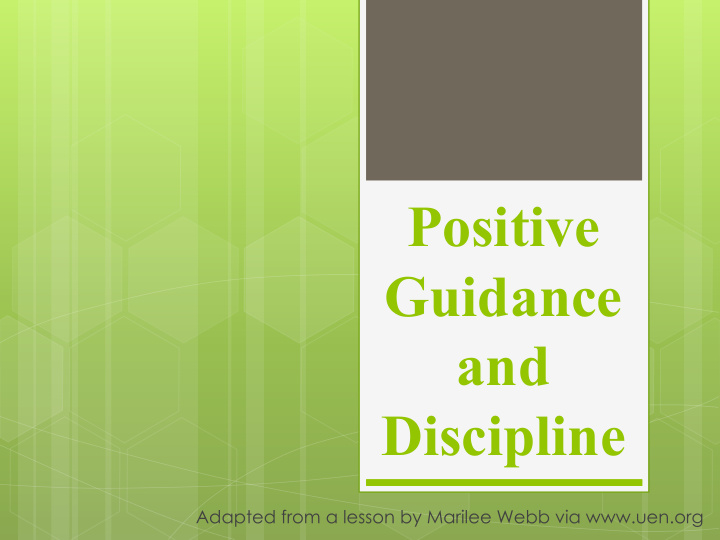



Positive Guidance and Discipline Adapted from a lesson by Marilee Webb via www.uen.org
Reasons for Misbehavior Stage of Growth: The child is behaving in a normal manner for the stage of growth he/she is in. Power, attention, revenge, feelings of inadequacy are normal
Reasons for Misbehavior Unfulfilled Needs: The child’s needs are not being met and she/he is acting out in order to try to get his/her needs met.
Reasons for Misbehavior Environment: The child is uncomfortable in or does not understand his/her environment. Doesn’t know Better: The child has not been taught the concept he/she is dealing with.
Use Discipline, not Punishment ○ Children may rebel when parents punish rather than discipline ○ Discipline is guidance which helps the child learn self-control ○ Tries to teach the child Self-discipline; the ability to direct one’s own behavior
Using Positive Guidance Effectively ○ Attention is one of the most powerful reinforcement to guide children; they often misbehave to get attention ○ Consistency is the key to guidance; children learn what to expect (or what they can get away with!) ○ Example: is a very effective way to teach children desired behavior ○ Respond to aggressive behavior in non-aggressive ways
Types of Guidance Techniques Please make a chart in your notebook that has 9 rows and three columns - we will be using the first column with the following slides
Write a definition for the technique Match the Technique Write your own solution to the problem: Natural Consequences Logical Consequences Positive Statements Redirection Reverse Attention
Write a definition for the technique Match the Technique Write your own solution to the problem: Limited Choices Time Out Positive Reinforcement Negative Reinforcement Limited Choices
Natural Consequences Occur without interference, child can see the result of their choices Example: if Bobby doesn’t wear a coat in the winter (after being given a reminder), he will be cold Cannot be used if the consequence will cause harm to self, others or property, or too far in the future.
Logical Consequences • Should be relevant to the misbehavior; To make the punishment fit the crime. • Example: if Sally spills the paint, she must clean up the mess that is made Short in duration, not imposed in anger, Must provide opportunities for children to learn from their behavior
Positive Statements • Say what you DO want children to do, not what you don’t want. Avoid words like: • No • Don’t • Stop • Example: “Walk to the playground” rather than “Don’t run” Start with an action verb! State what is expected, then help them get started. Be short and specific. Talk to children at their eye level
Redirection • Get the child to focus on something else. Children up to two years old can be easily distracted; is a good technique when children are too young to understand reason & logic • Example: if he is angry at the blocks area, lead him to a different area of the room and introduce a different activity
Reverse Attention • Ignoring the negative, reinforcing the positive • When a child’s behavior is inappropriate, focus on a child who is displaying the appropriate behavior and make a positive comment • If the first child changes his behavior, he should be immediately reinforced with a positive statement. • Example: Billy is pulling toys out instead of sitting at story time. Compliment Bob on how well he is sitting. Billy comes and sits, thank praise Billy for coming and joining the group
Limited Choices • Giving a child choice between a couple things • Only give choices that are available. • Do not give him an unlimited choice unless he can really have what is chosen. • Example: “Do you want juice or water?” rather than, “What would you like to drink?” • Example: “Would you like to go to bed now or after reading a story?”
Time Out • When a child has disobeyed a rule, she will be sent to a predetermined place to distance herself from the problem and gain composure. • Should be a last option, limited use. • A chance to distance themselves from a situation and cool down • Use a place where there are no distractions or positive reinforcements • Good rule of thumb - # of minutes = the child’s age • Example: Bobby cannot calm down after repeated reminders. Bobby sits on the timeout for 6 minutes until he is calm and ready to resume play.
Classic Conditioning: Positive & Negative Reinforcement Note: “positive” and “negative” refer whether it encourages or discourages the behavior. It doesn’t mean whether it results in good or bad behavior
Positive Reinforcement Something that encourages a certain action or behavior ○ EXAMPLE: Colton cleans up his room and gets to play a game with dad ○ EXAMPLE: Sally throws a fit in the store; her mother buys her a toy to get her to stop
Negative Reinforcement Discourages or extinguishes a certain behavior ○ EXAMPLE- Kayla hits her sister and gets put in time out ○ EXAMPLE- Joe comes home excited to show his mom his painting. Mom yells, “Not now! Can’t you see I’m busy?”
Should you use reinforcement all the time? According to BF Skinner’s studies on conditioning, the most effective way to encourage behavior change is when reinforcement is intermittent and unexpected
Recommend
More recommend